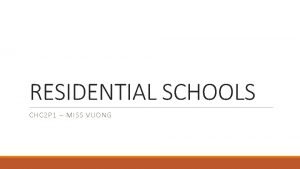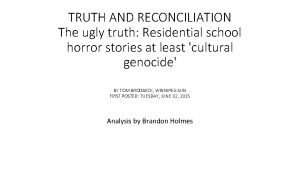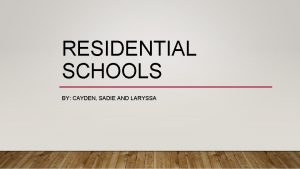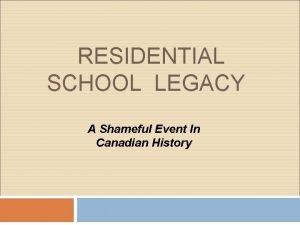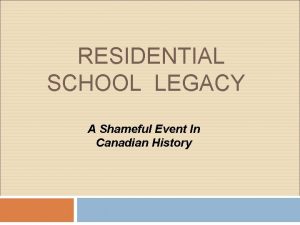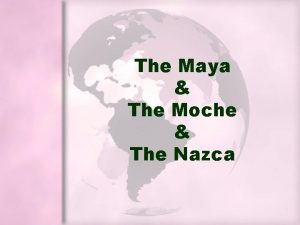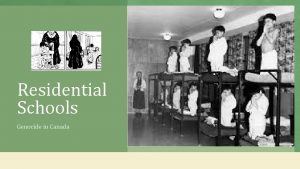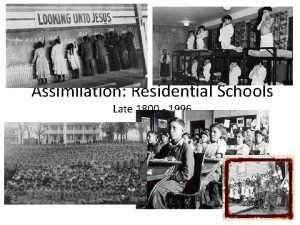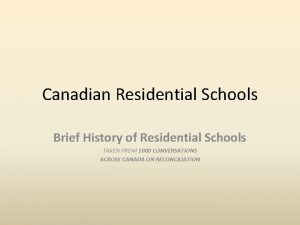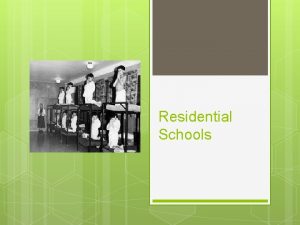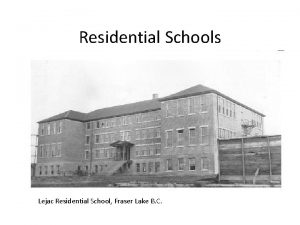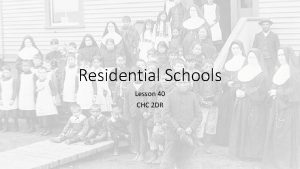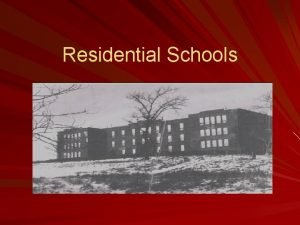Understand why Residential Schools were created Understand what












- Slides: 12


� Understand why Residential Schools were created � Understand what daily life was like in the Residential Schools � Understand the impact these schools had on the Aboriginal population and their belief system.

� Aboriginal peoples and European explorers and settlers have had both positive and negative effects on each other � 1755—British created the first Indian Dept of Canada in order maintain good relationships with the Aboriginals � 1900—Aborg. People near extinction due to warfare, diseases such as smallpox, measles, TB � 1876 and 1895—Indian Acts—encourage assimilation and established reservations

� Mid 1880 s, Canadian government funded residential school system � Children were removed from reserves and put far away at boarding schools run by the Catholic, United and Anglican religious orders � 1900 s -1960 s—they were taught it was wrong to practice their cultural ways and severely punished schools broke ties to communities and families children who had been isolated began to reject their past

� By 1986, most schools had either been closed or turned over to local bands. Ten years later, Gordon Residential School in Punnichy, SK, finally closed its doors. � Aboriginal communities have been carrying out the difficult work of supporting their members with residual issues surrounding the family breakdowns, violence and aimlessness brought about by residential schools.

� In 2005, the federal government established a $1. 9 -billion compensation package for the survivors of abuse at Aboriginal residential schools � In 2007, the federal government and the churches that had operated the schools agreed to provide financial compensation to former students under the Residential School Settlement Agreement. � On 11 June 2008, Prime Minister Stephen Harper, on behalf of the Government of Canada, offered an apology to all former students of Aboriginal residential schools in Canada.


� The purpose of the residential schools was to eliminate all aspects of Aboriginal culture. � Students had their hair cut short, they were dressed in uniforms, and their days were strictly regimented by timetables. � Boys and girls were kept separate, and even siblings rarely interacted, further weakening family ties.

� Abuse at the schools was widespreademotional and psychological abuse was present, physical abuse was given as punishment, and sexual abuse was also common. � Survivors recall being beaten and strapped, shackled to their bed, and some had needles shoved in their tongues for speaking their native languages. STOLEN CHILDREN VIDEO



� The Day of Apology
 Before and after residential schools
Before and after residential schools Tuberculosis in residential schools
Tuberculosis in residential schools Residential schools canada
Residential schools canada Residential schools horror stories
Residential schools horror stories Residential schools
Residential schools Residential school photos show legacy
Residential school photos show legacy Map of residential schools in canada
Map of residential schools in canada Why why why why
Why why why why To understand recursion you must understand recursion
To understand recursion you must understand recursion Huntsville powerschool
Huntsville powerschool Safety reach and target schools
Safety reach and target schools Nazca social structure
Nazca social structure All things were created by him
All things were created by him


